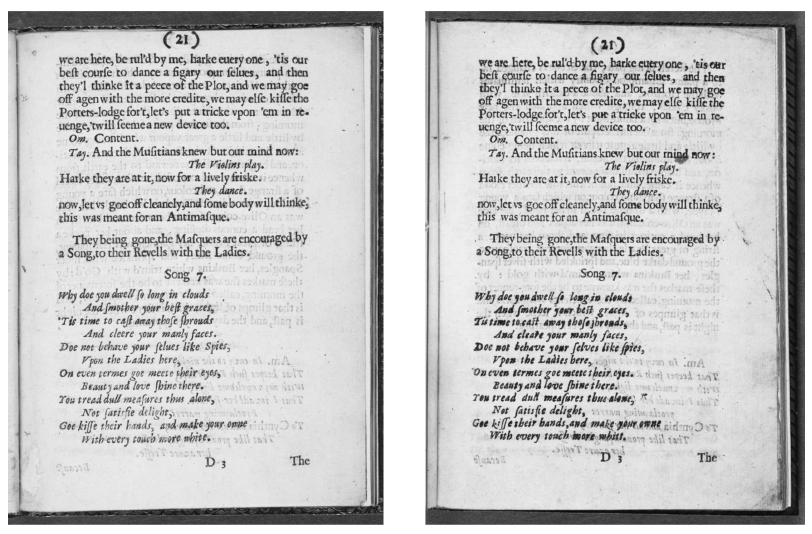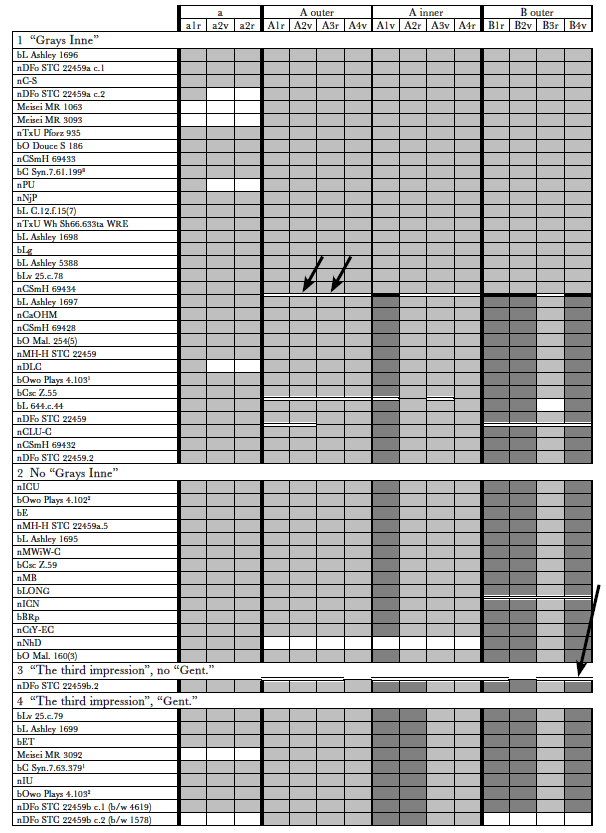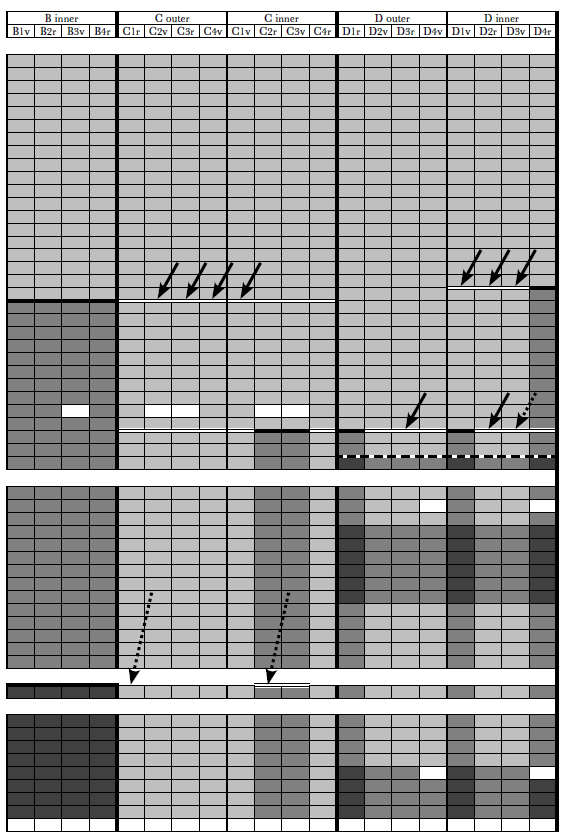| JAMES SHIRLEY'S TRIUMPH OF PEACE:
ANALYZING GREG'S NIGHTMARE
by
STEPHEN TABOR
| ||
§3. Italic Raids
Figure 3 shows a sort of mutation frequently found in ToP: the
entire song
(composed in italic type) has been reset, but not the passages in
roman above.
Note that short stretches of italic embedded in roman text remain
unchanged.
Eleven pages in ToP show this localized
resetting of italic at some point in the
printing history, and one of them (D2r)
has part of the italic reset yet again. Two
pages (including one that previously
had the italic changed) also show an arbi-
trary change-out of some of the roman type.
Table 4 shows where these resettings occur. (Solid arrows indicate replace-
ment
of italic type, dashed arrows the replacement of roman.) All of them, except
for
the roman replacement on C1r, occur at points in the production cycle where
the
numbers in the headlines were also reset—in other words, during the pauses
between
impressions that we have already identified. Table 5 presents the history
in
another way. (It contains codes for production phases and variant states which
I
will discuss later.) This table shows all the pages of ToP that
contain concentra-
tions of italic. A great deal of that type is used for the
songs that cluster toward
the end of the masque.
The local resettings do not always draw on the same font. In the earliest
states
of ToP, all the text—both roman and italic—is set in
"english" size (20 lines =
96 mm). In the first wave of changes, the italic Song 5
on C4V reappears in pica
size (82 mm). During the same transition, four lines of
italic stage direction on
A2v-3r switch to a 120 mm great primer. Pages C3v and
D3r are a more subtle
case: the reset songs are still in 96 mm italic, but the
font is of a different design,
which I will call i-2 as opposed to the more
prevalent i-1. The differences are
hard to describe, but we can compare the two in
figure 3. The page on the left
features Norton's regular english italic i-1, while
that on the right shows the song
reset in i-2—a less attractive face, smaller on
the body and also (in its ToP out-
ing) badly worn. The
most diagnostic feature of i-2 is the h, whose legs
nearly
close at the bottom, so that the letter resembles a b. In its i-1 cutting, the right
leg only begins to close.
None of these partial resettings result in substantive textual changes. Like
the
page-number resettings, they bear the marks not of perfectionism but rather of



and recourse to alternative, wrongly-sized, and sometimes inferior fonts strongly
suggest that they were a response to a shortage of type, that Norton was juggling
other jobs, and that ToP had to stand aside—even sacrifice some of its stand-
ing type—to let those jobs "play through". I therefore refer to these incidents
of localized distribution as "raids", which created holes in the composition that
Norton refilled once the more pressing need was past.
In §9, I will show that some of the italic distributed in the first raid ended
up
in ToP itself, in the two pages of dedication (leaf a2).
As part of the preliminaries,
these pages would have been printed after the main
text if Norton was following
the usual practice. Once the dedication was set, on
the other hand, it remained
substantially unchanged through the remainder of ToP s printing history. Norton
was able to muster enough
italic to restore the raided pages, though he some-
times patched the holes with a
mis-matched font. The first wave of raids liberated
about 2130 ens of italic, but
the preliminary quire of ToP contains only 42% of
that,
about 900 ens. Distributing more than twice the amount of needed type
might have
been a prudent action to ensure an adequate supply of all the sorts.
If there was
another job or jobs that prompted the italic raids, I have not been
able to
identify them. The candidates would obviously contain large amounts of
Norton's
english italic (96 mm). This was a slightly unusual size for standard text;
the
smaller pica served as the workhorse. In his books dated 1633–34,
Norton
used english-sized italic mostly for matter subsidiary to the main
texts—prelim-
inaries and indexes. The most extended stretch of it comes in the
twelve-page
index of Richard Verstegan's
Restitution of Decayed Intelligence (STC 21363),
dated
1634. It contains double columns of short lines of italic
with a heavy admixture of
roman. Its requirements hardly seem enough to stretch
the resources of a print-
ing house responsible for nearly thirty known jobs, or
parts thereof, during the
two-year span with ToP at its
center. It may be safest to hypothesize that Norton
was doing some job work now
vanished, maybe longer than a single sheet, greedy
for a larger size of italic
than usual, and urgent. The fact that the raids took place
at more than one point
in the ToP production suggests either several
ephemeral
jobs, or one larger project which for some reason has not survived.
In this section I have focused on localized resettings of italic passages in
re-
sponse to a need for type, but we need to bear in mind that any distribution of
type served to make it available for other jobs. We
will see instances throughout
the printing history of ToP
in which entire pages or formes were reset, with no
discernible pattern in which
pages were chosen. At the end of each printing
phase, Norton had three choices of
what to do with each type-page: (a) distribute
it, (b) keep the text standing and
strip the skeleton, or (c) keep the text stand-
ing with the skeleton intact. It
is quite possible that many of the resettings were
motivated by a need for more
roman type, and that the selection of pages was
driven by which type-pages were
accessible when the need arose.
It is now time to look at the variants in The Triumph of Peace
in detail. The
following sections, §4–8, are the densest
portion of this article and some readers
may find in them too much of a good
thing. Once we have dealt with the book
at the level of quire, forme, and
individual page, we will pull back to see how all



| Phase | A outer | B outer | C outer | C inner | D outer | D inner | ||||||||||||||||||
| A1r | A2v | A3r | A4v | B1r | B2v | B3r | B4v | C1r | C2v | C3r | C4v | C1v | C2r | C3v | C4r | D1r | D2v | D3r | D4v | D1v | D2r | D3v | D4r | |
| I | 1 | (1) | (1) | 1 | 1 | 1 | 1 | (1) | 1a | (1) | (1) | (1) | (1) | 1a | (1a) | (1a) | 1 | 1 | (1) | 1a2 | (1) | (1) | (1) | (1) |
| II | 2a | [2a] | [2a] | 2a | 2a | 2a | 2a | (2a) | 1b | [2a] | [2a] | [2a] | 2 | 1b | (1b) | (1b) | 1 | 1 | (1) | 1a2 | [2] | [2] | [2] | {2} |
| III | 2b | 2b | 2b | 2b | 2b | 2b | 2b | (2b,c) | 1c | 2b | 2b | 2b | 3 | 2 | {2} | 1c | 2 | 2 | [2] | 1b | 3 | [3] | 3 | 3 |
| IV | [3] | |||||||||||||||||||||||
[] = only italic reset
{} = entirely reset
of the changes fit into the production sequence of multiple printings. In §9–10,
I will demonstrate how recurring types give evidence of the order of printing
the formes; in §11–14, I will show how copies were assembled from the stock
of printed sheets on hand. Section 15 presents the entire workflow as a series
of specific actions, and §16 addresses basic issues like edition size and the time
required to print all the copies. The metamorphosis of the printed pages entails
a textual evolution in which deliberate revisions (mostly to the stage directions)
appear amid a chatter of accidentals generated by the resettings. I have reserved
a detailed account of these for the textual introduction to ToP in the upcoming
Oxford University Press edition of Shirley's works.
My method of organizing the variants is, I hope, as simple as the situa-
tion
allows, but it still needs a bit of explanation. The comprehensive catalogue
of
manifestations of all the pages, from complete resettings down to stop-
press
variants and even the occasional random shift, will be found as appendix 1. It
is
modeled on a biologist's taxonomic key, and as with all such keys the
identi-
fication marks are the minimum required to distinguish the states; seldom
are
all the variants on a page mentioned. During the first stages of organizing
this
list, I saw the need for some kind of shorthand to refer to each state of a
page.
Ideally the structure of this shorthand should express the hierarchical
relation-
ships of the states of each page, with the main settings at the top
level followed
by impositions at the next and stop-press variants at the bottom.
However, as
the families of variants continued to ramify—sometimes manifesting
states that
would not fit neatly into any hierarchy—practice sometimes overruled
theory,
and the codes ceased to reflect any rigid correspondence with production
phases
or the relative importance of the changes they denote. Attempting at this
point
to revise the codes to make them more consistent—to the extent that that
would
even be possible—would render precarious their connection with notes
taken
over two decades, which embody the current system in a well-documented
pro-
cess of evolution. For specification of the exact relationships between the
states,
the reader should refer to appendix 1.

| JAMES SHIRLEY'S TRIUMPH OF PEACE:
ANALYZING GREG'S NIGHTMARE
by
STEPHEN TABOR
| ||

